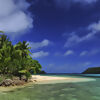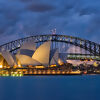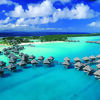20 Nights | TASMAN & PACIFIC GEMS
You will visit the following 12 places:

Tauranga
Tauranga is the most populous city in the Bay of Plenty Region of the North Island of New Zealand. It was settled by Māori late in the 13th century and by Europeans in the early 19th century and was constituted as a city in 1963. Tauranga is one of New Zealand's main centres for business, international trade, culture, fashion and horticultural science. The Port of Tauranga is also New Zealand's largest port in terms of gross export tonnage and efficiency. It is one of New Zealand's fastest growing cities, with a 14 percent increase in population between the 2001 census and the 2006 census, though that number has slowed to 11% between the 2006 Census and the 2013 Census.

Tahiti
Tahiti is the largest island in French Polynesia, the South Pacific archipelago. This overseas collectivity of the French Republic is sometimes referred to as an overseas country. The island was formed from volcanic activity and is high and mountainous with surrounding coral reefs. Tahiti was originally settled by Polynesians between 300 and 800 CE. They represent about 70% of the island's population with the rest made up of Europeans, Chinese and those of mixed heritage. The island was part of the Kingdom of Tahiti until its annexation by France in 1880, when it was proclaimed a colony of France. It was not until 1946 that the indigenous Tahitians were legally authorised to be French citizens. French is the only official language although the Tahitian language (Reo Tahiti) is widely spoken.

Pago Pago
Pronounced "Pahngo-Pahngo" in the Samoan language, Pago Pago is the territorial capital of American Samoa. In 2010, its population was 3,656. The city is served by Pago Pago International Airport. Tourism, entertainment, food, and tuna canning are its main industries. It is on the island of Tutuila.

Tonga
Tonga is a Polynesian kingdom of more than 170 islands, many uninhabited, most lined in white beaches and coral reefs and covered with tropical rainforest. Tonga became known as the Friendly Islands because of the congenial reception accorded to Captain James Cook on his first visit in 1773. He arrived at the time of the ʻinasi festival, the yearly donation of the First Fruits to the Tuʻi Tonga (the islands' paramount chief) and so received an invitation to the festivities. The island acquired its independence in 1970 and became a member of the Commonwealth of Nations. It is one of the few indigenous monarchies in the Pacific.

Melbourne
Melbourne is the capital and most populous city in the state of Victoria, and the second most populous city in Australia. The Melbourne City Centre (also known as the "Central Business District" or "CBD") is the hub of the greater geographical area (or "metropolitan area") and the Census statistical division—of which "Melbourne" is the common name. As of June 2009, the greater geographical area had an approximate population of four million. In Southbank, the Melbourne Arts Precinct is site of Arts Centre Melbourne – a performing arts complex – and National Gallery of Victoria, displaying Australian and Indigenous art.

Sydney
Sydney is the largest and most populous city in Australia and the state capital of New South Wales. The city is located on Australia's south-east coast of the Tasman Sea. It is also the oldest and most cosmopolitan city in Australia with an enviable reputation as one of the world's most beautiful and liveable cities. Brimming with history, nature, culture, art, fashion, cuisine, design, Sydney's set next to miles of ocean coastline and sandy surf beaches. Long-term immigration has led to the cities reputation as one of the most culturally and ethnically diverse cities in Australia and the world. The city is also home to the Sydney Opera House and the Sydney Harbour Bridge, two of the most iconic structures on this planet.

Picton

Bora Bora
Bora Bora is an island in the Leeward group of the Society Islands of French Polynesia, an overseas collectivity of France in the Pacific Ocean. The original name of the island in the Tahitian language might be better rendered as Pora Pora, meaning "First Born"; an early transcription found in 18th- and 19th-century accounts, is Bolabolla or Bollabolla. The island, located about 230 kilometres (140 mi) northwest of Papeete, is surrounded by a lagoon and a barrier reef. In the center of the island are the remnants of an extinct volcano rising to two peaks, Mount Pahia and Mount Otemanu, the highest point at 727 metres (2,385 ft). Bora Bora is a major international tourist destination, famous for its aqua-centric luxury resorts. The island is served by Bora Bora Airport on Motu Mete in the north, with Air Tahiti providing daily flights to and from Papeete on Tahiti. The major settlement, Vaitape is on the western side of the main island, opposite the main channel into the lagoon.

Auckland
The Auckland metropolitan area in the North Island of New Zealand, is the largest and most populous urban area in the country with 1,354,900 residents, 31 percent of the country's population. Auckland also has the largest Polynesian population of any city in the world. In Māori Auckland's name is Tāmaki Makaurau, or the transliterated version of Auckland, Ākarana. The 2010 Mercer Quality of Living Survey ranked Auckland 4th equal place in the world on its list, while The Economist's World's Most Livable Cities index of 2010 ranked Auckland in 10th place. In 2008, Auckland was classified as an Alpha World City in the World Cities Study Group’s inventory by Loughborough University.

Napier
Napier is a New Zealand city with a seaport, located in Hawke's Bay on the eastern coast of the North Island. About 18 kilometres south of Napier is the inland city of Hastings. These two neighbouring cities are often called "The Bay Cities" or "The Twin Cities" of New Zealand. Napier is a popular tourist city, with a unique concentration of 1930s Art Deco architecture, built after much of the city was razed in the 1931 Hawke's Bay earthquake. It also has one of the most photographed tourist attractions in the country, a statue on Marine Parade called Pania of the Reef. Thousands of people flock to Napier every February for the Tremains Art Deco Weekend event, a celebration of its Art Deco heritage and history. Other notable tourist events attracting many outsiders to the region annually include F.A.W.C! Food and Wine Classic events, and the Mission Estate Concert at Mission Estate and Winery in the suburb of Taradale.

Burnie
Burnie is a port city on the north-west coast of Tasmania. When founded in 1827, Burnie was named Emu Bay but it was renamed for William Burnie, a director of the Van Diemen's Land Company, in the early 1840s. At the 2011 Australian Census Burnie had an urban population of 19,819, making it the fourth largest city in Tasmania. Burnie together with nearby Wynyard had an estimated urban population of 26,869 at June 2015. Burnie is governed by the City of Burnie local government area.










